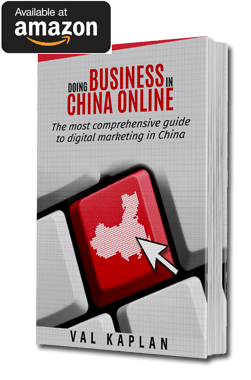This article was first published by Hal Conick of American Marketing Association (AMA.org).
A growing internet user base means a smaller world for marketers. How can marketers break into markets like Japan, China and Germany? Marketing News spoke with experts from across the world to find out. The first interview about breaking into Chinese market is with Val Kaplan, author of Doing Business in China Online:
Basic facts:
China GDP: $11 trillion
Chinese advertising spending (per ZenithOptimedia): $74.4 billion
Q: What’s the top marketing challenge in China?
A: The complexity of the entry requirements for marketers who are unfamiliar with the local market. This is especially true for online and digital marketing, where most of the action takes place. For example, if an American company wants to advertise its product with a search engine in a German market, all it would need are a Gmail account and a credit card. In China, that company would have to first register an overseas advertiser’s account with search engines such as Baidu (Google has near zero market share and is blocked here), pass verification that can take several weeks, pay fees and place a deposit. Other marketing channels — such as the hugely popular WeChat — do not accept foreign advertisers at all. Therefore, registering a legal entity in China is often the first step before one can take advantage of the tools used by marketers. These regulations have to do with the fact that the internet in China is tightly regulated by the government and the grip is getting tighter every year.
Q: What is the top trend in Chinese marketing?
A: A general trend over the last few years has been continued domination of the mobile element of Chinese marketing. WeChat, the biggest social media platform with more than 900 million active users, is exclusively mobile. Most internet searches are done via mobile. More products are sold from mobile e-commerce apps than PC-based browsers. In fact, the smartphone was the primary device people used to get online in China a few years before it happened in the West. There is no doubt that this trend will continue for the foreseeable future.
As for the hottest trend in the past year, it would probably be live streaming. This market has grown at an astonishing rate, giving rise to an entirely new ecosystem of related technologies, services, platforms and an army of influencers who are called KOLs (key opinion leaders) in China.
Q: What’s the biggest difference between marketing in the U.S. and marketing in China?
A: The most obvious difference would be a completely different set of tools. While Google and Facebook dominate the American digital advertising market, they are irrelevant in China. The largest search engine in China is Baidu, which holds about 60% market share, but there are others as well. In social media, WeChat dominates mobile space and Sina Weibo, a local hybrid of Facebook and Twitter, already has more users than Twitter. More than 70% of the e-commerce market share is held by Alibaba, which sells more products from its Taobao and Tmall platforms than Amazon and eBay combined. JD.com, another e-commerce giant, holds 25% of that market. The Chinese marketing landscape is completely different from what American marketers are familiar with.
Marketing expert Val Kaplan on China’s education market
Q: What’s the hottest technology in China right now? How do marketers use it?
A: WeChat is the hottest technology on the market right now. The sheer number of users, which now stands at about three times the entire U.S. population, is mind-boggling. WeChat offers companies a possibility to connect with an enormous user base via official accounts and, most recently, with mini-apps. On the downside, acquiring followers on WeChat is not as straightforward as other channels due to the private nature of the platform and limited advertising options. The quality of followers tends to be higher on WeChat versus other social media networks, which is what makes WeChat marketing an essential element of overall strategy for Chinese marketing. Today, it is hard to find a single company in China that doesn’t have a WeChat channel. Some new companies even forgo setting up a website altogether in favor of a WeChat official account.
Q: What’s the one thing an American marketer looking to launch or market a campaign in China needs to know?
A: The first thing to know is that the marketing tools at one’s disposal are going to be completely different: Baidu and Qihoo are the main search engines, Weibo is an equivalent of Facebook/Twitter, Youku is “Chinese YouTube,” and WeChat is a whole new beast without a direct equivalent in the U.S. market. In addition, none of those channels offers an English backend control, so unless you are fluent in Chinese and familiar with how they operate, you’d need to find experts to run them for you.
If you are planning to sell directly to Chinese consumers, keep in mind that the payment systems are different, too. Alipay and WeChat Pay are the dominant payment methods online, on mobile and increasingly offline as well. Practically no one in China has heard of PayPal, and very few use credit cards for online purchases. Localization takes a whole new meaning for the Chinese market compared to Europe or even Japan.
Q: Would it be easy for an American company to roll out in China?
A: It won’t be as easy as entering other markets, but as long as they know what they are doing, they are going to be fine. Essentially, it comes down to committing a larger marketing budget up front. Setting up a local business entity would open marketing options that are unavailable to companies that are only registered overseas. Testing the market is almost impossible on a bootstrap budget: There are no options to run a Facebook campaign on $50 per day to “test the waters” to decide whether the Chinese market holds enough potential. Unless a company is committed to spend up front to register a company, set up local marketing channels and find experts and consultants to run them, there aren’t many options.
Q: What does the short-term future hold for marketing in China? Any guesses for the long-term future?
A: Short-term, it’s safe to say that WeChat will continue on its path to dominate the market by expanding its capabilities. One such trend has become evident since the launch of WeChat’s enhanced search function, which set the platform on a collision course with traditional search engines like Baidu and Qihoo. New functions are being gradually integrated within the app that will offer more advertising and analytical tools to marketers. E-commerce powered primarily by Alibaba will probably see more integration with other online properties that it owns in video, social and entertainment spaces.
It’s much harder to predict the long-term future. If I had to guess, I’d say that the competition within the notorious BAT — the name for three Chinese tech giants Baidu, Alibaba and Tencent (the maker of WeChat) — is going to intensify. They would probably diversify into more areas, taking advantage of their unique strength: Baidu will start reaping benefits from its early investment in AI technology, Alibaba will consolidate its shopping and entertainment empire, and Tencent will connect people with technology through WeChat. One can only imagine what new marketing tools and possibilities we are going to see then.






